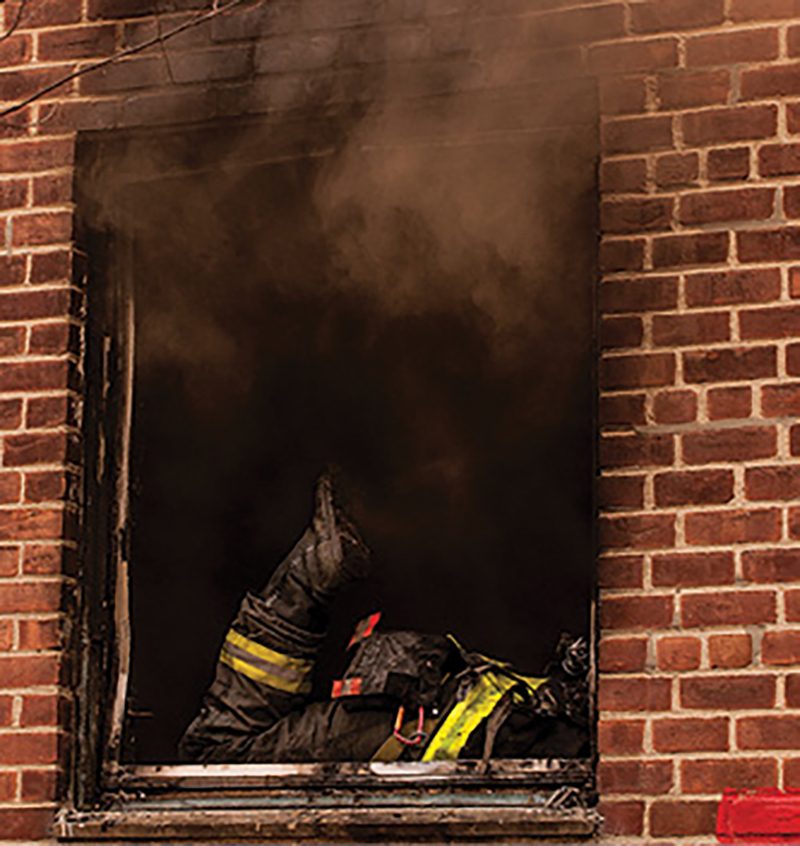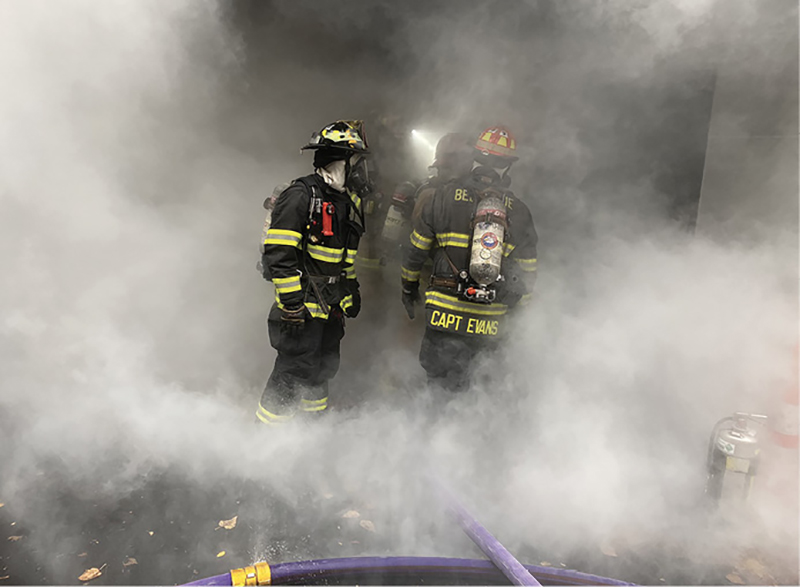By Brian Brush and Anthony Kastros
Whether it’s the dispatcher reporting “Known parties trapped” at the time of the call, the first-arriving company officer finding occupants at a window on arrival, or a search crew locating a victim in a hallway, rescuing a civilian at a working fire is an incident within the incident (IWI).
- Civilian Rescue: The Reason We Exist
- Incident Command and Succession Planning
- The Tactical Gap
- Search Mission Prep: Size-Up, Methods, and Tools
We anticipate, practice, promote, and even dictate that a fire incident has an incident commander (IC) to supervise and coordinate the communication and actions of fire attack, search, ventilation, water supply, and so on. Given that the rescue of a civilian at these incidents will require responders to locate, remove, triage, and possibly treat and transport, all within a working fireground, tactical and strategic officers should spend time anticipating the need, practicing the role, and promoting the proactive establishment of rescue group supervisors. This is even more critical in organizations or areas where emergency medical services (EMS) is a separate agency or EMS communication is conducted on a separate radio channel (photo 1).
Potential
The 2021 Fireground Civilian Rescue Research Project1 found that in the United States, firefighters are making an average of almost 10 rescues a day. From the Firefighter Rescue Survey data,2 we learn that most rescues and civilian victim removals require the efforts of at least one and often two full companies. This should not surprise us when we consider the rapid intervention team (RIT) studies conducted by the Phoenix (AZ) Fire Department and many others following the Bret Tarver incident. They determined it often took 12 firefighters to rescue and remove a single down firefighter. Note that these ratios do not account for companies or EMS crews required for the victim’s triage, treatment, and transport after removal; they are needed specifically for rescue and removal. At a possible frequency of more than 3,000 rescues a year and the probability that the rescue will involve multiple firefighters, the statement “You could go your whole career without making a rescue” is true, but the odds of being part of a rescue operation are better than most think.
Preparation
Most fire departments respond to fire incidents with just enough resources to handle the tasks associated with a working room-and-contents fire or involve just a few rooms of fire in a single-family dwelling. An automatic upgrade to a second alarm is common in many agencies when immediate exposures include neighboring homes, commercial units, or the upper floors of a multifamily dwelling. Although this is good practice, it is only increasing the resource availability to the level of potential at that time, which is not always synonymous with “getting ahead.”
Another common practice is an automatic upgrade of resources assigned for a Mayday. The premise of this is often connected to the finding in the Phoenix RIT studies that a Mayday is an IWI that would reduce the firefighting force by at least the member having the Mayday and up to 12 more involved in the attempted rescue (photo 2).
From the data collected through the Firefighter Rescue Survey2, about 70 percent of the time when a civilian is rescued from a fire, the crews were advised either at the time of dispatch or on arrival that there was a trapped party. Unlike a firefighter Mayday, this preoperation information provides the opportunity to set up the scene for simultaneously managing/mitigating a fire problem and a rescue problem. Putting a fire out alone will not “make everything better.” Smoldering fires will continue to produce toxic gases—no nozzles can locate and remove victims. Modern fires mean modern victims will succumb to the toxic gases much more quickly. We must have a proactive, multifaceted approach to rescue, which includes fire attack, rescue, ventilation, treatment, and transport. All must be coordinated simultaneously and rapidly with little to no margin for error.

(1) Firefighters transfer a fire victim to EMS for treatment and transport. (Photos 1-2 by Lloyd Mitchell.)

(2) A firefighter conducts a window-initiated search.
From the Underwriters Laboratories’ study “Impact of Fire Attack Utilizing Interior and Exterior Streams on Firefighter Safety and Occupant Survival Tactical Considerations”3: “Although survivable spaces exist at the time of fire department arrival (Section 7.4), the survivability potential decreases as the time of exposure increases. When resources permit, interior search and rescue operations can and should proceed simultaneously regardless of the fire attack tactic selected. Removing any potential victim from the hazardous atmosphere as soon as possible after arrival is essential to minimizing the Fractional Effective Dose (FED), therefore increasing their chance of survival.”
In contrast to the 70 percent of rescues in which there was prior knowledge of victims, the other 30 percent of rescues occurred when victims were discovered without prior information or in a reactive posture. These “unknown victim located” situations can be detrimental to the fireground resources of an IC who is not anticipating rescue since it compels management and resolution on the fly. With that said, just as the fire service has developed and rehearsed responses to unexpected firefighter-down situations, the same methodology and process apply here.
If a search crew discovers a victim, we can anticipate that will interrupt their search, thereby leaving it incomplete and in need of reassignment. Removing the victim will require a minimum of that crew and possibly more. On the victim’s removal to the exterior, the victim will need to be assessed, possibly treated, and transported. All these tasks will require resources and coordination to support and reinforce not only the rescue’s success but also for fire control. In a firefighter-down situation, for most agencies, “Mayday, Mayday, Mayday” is the trigger for immediate and clear communication, resource allocation, and coordination protocols. Most of these same actions would directly support the management and outcome of a “Victim, Victim, Victim” scenario.
Command for the Rescue
With known victims or a high probability of victims, the IC should consider establishing a rescue group, led by a single rescue group supervisor (RGS). Unlike crews conducting a primary search and discovering an unknown victim, the known-victim scenario presents challenges even before crews initiate fire attack and search, let alone go inside and find the victims.
When one or more victims are known to be trapped en route or on arrival, chaos often ensues just as companies arrive. Crews’ adrenaline kicks in while auditory exclusion and tunnel vision instantly become barriers to situational awareness, tactical decision making, risk assessment, communication, coordination, and accountability. The potential for conflicting or redundant effort increases. Some officers want to go for the grab, while others may want to perform transitional attack; or, everyone is going for the grab while no one puts water on the fire.

(3) Face-to-face communication at the threshold of the hot zone between the group supervisor and his crews maximizes communication accuracy while minimizing radio traffic. (Photo by Anthony Kastros.)
As previously mentioned, the IWI nature of a known victim has a similar effect on the fireground as a Mayday in that the pace picks up, additional resources are needed, and tactical frequencies become overloaded. This will cause the IC to get behind the incident’s power curve wherein the span of control is overwhelming and the ability of the IC to forecast, support, and maintain order becomes difficult at best.
One way to prevent these predictable circumstances is by establishing the RGS early in an incident that has known victims. This will decentralize the daunting task of coordinating multiple resources in a truly life-and-death situation when seconds count. The RGS must be positioned in the tactical space, at the threshold of the hot zone, where the victim is likely to be brought out. Here, the RGS can perform face-to-face communications with multiple crews to minimize time-to-task intervals while minimizing radio traffic (photo 3).
RGS Roles and Responsibilities
The RGS must remain hostile, agile, and mobile. Hostile means exhibiting a strong command presence and owning the space and function of the rescue tactics. Take over control of the situation. Provide clear, decisive direction and the crews will follow. Agile means maintaining accountability of multiple crews performing rescue, removal, and patient care while keeping the IC in the loop regarding conditions/actions/needs reports. Finally, mobile means moving among the locations where crews are working and multiple victims are coming out.
If a medical group is also established (and it should be), the RGS and medical group supervisor (MGS) must coordinate laterally. This means that the RGS must share information, ideally face-to-face, with the MGS regarding number, exit location, age, and size of the victims to be rescued. The MGS must ensure that the proper treatment resources are on scene and transport capabilities are abundant for the number of victims, including ensuring firefighters ride to the hospital if needed for extra patient care. Plan on members from rescue group companies to be taken to the hospital to assist with patient care if no other personnel are available. The RGS and MGS must coordinate accountability and keep the IC updated on resource needs and status.
Finally, the RGS must ensure that all secondary searches are completed, and the MGS must ensure that at least one transport medic unit is on scene for additional unknown victims or firefighters.
Unlike an unknown victim found during a primary search or a firefighter Mayday in the middle of a fire, a known victim situation communicated while responding to or on arrival at a working fire creates an opportunity to enhance the level of tactical coordination and organization of resources. The use of the RGS, along with the MGS, allows the maximum coordination and efficiency of these two critical tactical objectives.
Calling additional resources ensures that the IC’s span of control remains manageable and radio traffic is minimized while communications and accountability are maximized. Each of these factors can reduce time-to-task, confusion, and redundant/conflicting effort and save seconds, which may make all the difference.
Endnotes
1. Brush, Brian. 2021 Fireground Civilian Rescue Research Project, Oklahoma State University.
2. Firefighter Rescue Survey, www.FirefighterRescueSurvey.com.
3. Underwriters Laboratories Firefighter Safety Research Institute. (2018) Impact of Fire Attack Utilizing Interior and Exterior Streams on Firefighter Safety and Occupant Survival. UL-FSRI, Columbia, Maryland. https://bit.ly/3usP2Yr.
Brian Brush is a 26-year veteran of the fire service. His experience spans from rural volunteer to metro-sized departments. Brush is the training chief for the Midwest City (OK) Fire Department. A contributor to Fire Engineering, he is a on the FDIC International advisory board and has been an FDIC International H.O.T. and classroom instructor for more than 10 years. He has a master’s degree from Oklahoma State University School of Fire Protection and Emergency Management and is a graduate of the National Fire Academy’s Executive Fire Officer Program.
Anthony Kastros is a 33-year fire service veteran. He is the author of the Fire Engineering book and video series Mastering the Fire Service Assessment Center–2nd Edition and Mastering Fireground Command–Calm the Chaos! Kastros received the 2019 George D. Post Instructor of the Year Award from the ISFSI and Fire Engineering. He is the founder of Trainfirefighters.com, teaching command, tactics, and officer development throughout America.

